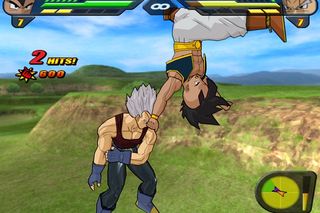To accommodate them all, the game's story mode - Dragon Adventure - features no fewer than 24 different storylines, including a few cool "what if?" scenarios. Whichever plot you choose, though, they all play more or less the same - you'll fly around over a big world map as whichever character(s) the story dictates, visiting shops and picking up items before each chapter-ending fight. The whole experience is structured like an RPG, meaning you'll be able to power up and customize your fighters for use in other modes.

The fights themselves are shaping up to be surprisingly addictive, considering how simple they are. Like the previous Tenkaichi, they unfold from a third-person perspective (two-player battles get a split screen), and they're all about the aerial fisticuffs and gigantic fireballs - both of which are super-easy to pull off by just mashing buttons.
Super-moves or no, each battle tends to devolve into patterns of punching, charging your ki energy and letting loose with massive, searing energy blasts. It's repetitive, but it's so fast and visceral that it took us a long time to notice.
It helps that the story mode doesn't hold you too strictly to canon. Each character has all their ridiculous Super Saiyan/giant ape/whatever transformations available right off the bat, and can activate them in the middle of a match once they've powered up enough, enabling you to unleash massive ass-kickings.
Cool stuff you can do mid-match doesn't stop with transformations, either. During the new Tag Battles, for instance, you can switch to a second character, and if you've chosen a certain character combination - like Goku and Vegeta, say - you'll be able to pull off a Fusion move and create a whole new fighter.

